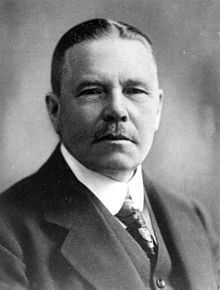Swedish general election, 1932
Swedish general election, 1932

|
|
|
|
| All 230 seats in the Riksdag |
| |
First party |
Second party |
Third party |
| |
 |
 |
|
| Leader |
Per Albin Hansson |
Arvid Lindman |
Olof Olsson |
| Party |
Social Democratic |
Electoral League |
Farmers' League |
| Last election |
90 |
73 |
27 |
| Seats won |
104 |
58 |
36 |
| Seat change |
 14 14 |
 15 15 |
 9 9 |
| Popular vote |
1,040,689 |
585,248 |
351,215 |
| Percentage |
41.7% |
23.5% |
14.1% |
|
| |
Fourth party |
Fifth party |
Sixth party |
| |
 |
 |
 |
| Leader |
Carl Gustaf Ekman |
Nils Flyg |
Eliel Löfgren |
| Party |
Free-minded National |
Kilbommare Communist |
Liberal |
| Last election |
28 |
new |
4 |
| Seats won |
20 |
6 |
4 |
| Seat change |
 8 8 |
 6 6 |
 0 0 |
| Popular vote |
244,577 |
132,564 |
48,722 |
| Percentage |
9.8% |
5.3% |
2.0% |
|
| |
Seventh party |
|
|
| |
 |
|
|
| Leader |
Sven Linderot |
|
|
| Party |
Communist |
|
|
| Last election |
8 |
|
|
| Seats won |
2 |
|
|
| Seat change |
 6 6 |
|
|
| Popular vote |
74,245 |
|
|
| Percentage |
3.0% |
|
|
|
|
General elections were held in Sweden on 17 and 18 September 1932.[1] The Swedish Social Democratic Party remained the largest party, winning 104 of the 230 seats in the Second Chamber of the Riksdag.[2] The party returned to government after six years in opposition, marking the beginning of 44 years of near-uninterrupted rule (the only exception was three months in 1936).
Results
| Party |
Votes |
% |
Seats |
+/– |
|---|
| Swedish Social Democratic Party | 1,040,689 | 41.7 | 104 | +14 |
| General Electoral League | 585,248 | 23.5 | 58 | 15 |
| Farmers' League | 351,215 | 14.1 | 36 | +9 |
| Free-minded National Association | 244,577 | 9.8 | 20 | –8 |
| Communist Party of Sweden (Kilbommare) | 132,564 | 5.3 | 6 | New |
| Communist Party of Sweden (Sillénare) | 74,245 | 3.0 | 2 | –6 |
| Liberal Party of Sweden | 48,722 | 2.0 | 4 | 0 |
| Swedish National Socialist Party | 15,170 | 0.6 | 0 | New |
| Other parties | 2,676 | 0.1 | 0 | 0 |
| Invalid/blank votes | 6,060 | – | – | – |
| Total | 2,501,166 | 100 | 230 | 0 |
| Registered voters/turnout | 3,698,935 | 67.6 | – | – |
| Source: Nohlen & Stöver |
References
- ↑ Nohlen, D & Stöver, P (2010) Elections in Europe: A data handbook, p1858 ISBN 978-3-8329-5609-7
- ↑ Nohlen & Stöver, p1872





